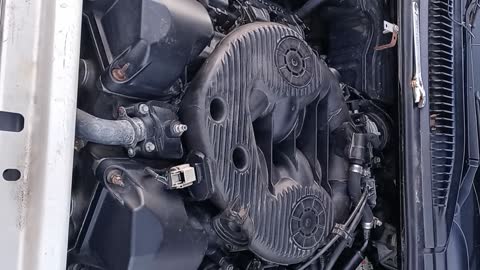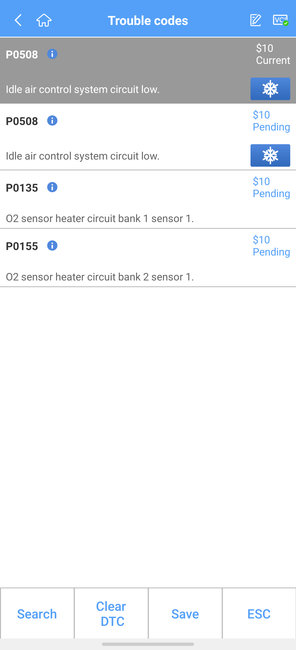Dandy video. It has to be running on more than two cylinders. As a point of interest, we were learning about automatic idle speed motors at a Chrysler school I attended back in the early '90s. The instructor was showing us how much control the Engine Computer had over idle speed. Part of that demonstration was performed on an 8-cylinder Jeep engine. He unplugged a fuel injector, idle speed dropped, the computer saw that, and increased idle speed back to the desired speed. Each time he unplugged another injector, the computer brought the engine back up to speed. Eventually he had seven injectors unplugged. Obviously the engine was running very poorly, but it was still at the correct idle speed, and the AIS motor was not yet at the end of its travel.
The computer is also going to detect the misfires and set diagnostic fault codes indicating which ones are not firing. You can feel the misfires because crankshaft rotational speed slows down when a misfire occurs. That is the same way the computer knows which cylinder is misfiring. It knows where the crankshaft is when it slows down momentarily.
There's two things that can block a misfire code from being set. One is when there are multiple cylinders misfiring at the same time, the computer may have trouble figuring out which ones are affected. You're more likely then to get code P0300, multiple cylinder misfire. We have to look at what all of those cylinders have in common. One thing could be low fuel pressure. Most people think of the computer first, but in fact, it has six individual ignition coil driver circuits. Computer failures are not at all common, and to have even one driver circuit fail is almost unheard of, let alone multiples at the same time.
The second thing is for any fault code to set, there is always a long list of conditions that must be met, and one of those conditions is certain other codes can't already be set. The best example of this is when the engine has been off for at least six hours, the computer knows the coolant temperature sensor and the intake air temperature sensor had better be reading the same temperature. When they are not reading the same when the engine is started, the computer has ways of figuring out which one is wrong or if it just needs to relearn or update their values. No two sensors are ever exactly alike, so to prevent needing to make all kinds of adjustments when a sensor is replaced, the computer is designed to learn the personality of a new sensor. There are other "hard" defects that will result in a code being set, but in this example, if a code is already set for the intake air temperature sensor, the computer knows it can't rely on its readings to use for comparing to the coolant temperature sensor. Other than those hard defects, like cut wires, the computer will suspend tests related to sensor calibration, meaning signal voltages it expects to see during normal operation. It still has learned data stored for the CTS, so it still knows coolant temperature, as long as you don't replace that sensor. If you do, it might see coolant temperature as being slightly higher or lower than it really is, but that won't cause a fault code to set.
A similar story can be told for code P0622. Technically 13.9 volts is in the acceptable range, but it is still on the low side. We'd like to se it closer to 14.5 volts. We still don't know the cause of code 622, but that could be on the list of codes that can't already be set when running tests for misfires. It's possible the low or unstable charging voltage could mean the ignition coils are developing weak spark, and as far as the computer is concerned, multiple cylinder misfires are to be expected, so it refuses to set misfire codes because those could be misleading or confusing and make diagnosis take longer.
The first thing I would look at is fuel pressure with the engine running. Normal is:
Fuel System Pressure. 400 kpa ± 34 kpa (58 psi ± 5 psi)
The next step would be to use the scanner, under the "Actuator" test menu, to fire each ignition coil one at a time. With this type of coil, you'll have to insert a screwdriver to reach the terminal, then watch if spark jumps from the screwdriver to the engine. Without that extension, spark voltage is likely to not be high enough to jump that far. This test will verify each coil is okay, along with the individual driver circuits in the computer.
Next would be to look at the signals coming from the crankshaft position sensor and the camshaft position sensor. Unlike most other sensors where the acceptable range of signal voltage is from 0.5 to 4.5 volts, these two develop signals that switch from "low" to "high", typically from close to 0 volts to close to 5 volts. The exact voltage is irrelevant. These are used for timing, so it's only the transition points that are critical. By the time the diagnosis has gotten this far, we're looking for something unusual or uncommon. Most newer scanners can graph these signals, but they occur too fast to watch. Instead, there is usually a "record" feature that lets us record a few seconds of sensor data, then we can play it back slowly later to see what happened. As an example, crankshaft position sensors on some older engines needed to have their air gaps set very precisely. That was very easy to do if procedures were followed, but I have been known to be arrogant enough to not need those procedures. If the air gap is wrong, it can result in intermittent stalling, or it could be just on the edge of reading or not reading the notches in the flex plate that the sensor uses to generate its signal pulses. That could result in the computer not seeing when to fire some injectors or ignition coils.
Your crankshaft position sensor and camshaft position sensor have mounting flanges that eliminate the need for setting the air gap manually, but who is to say someone didn't replace one in the past and left the mounting bolt loose? That would be the type of unusual thing we would be looking for.
Monday, March 22nd, 2021 AT 5:46 PM





